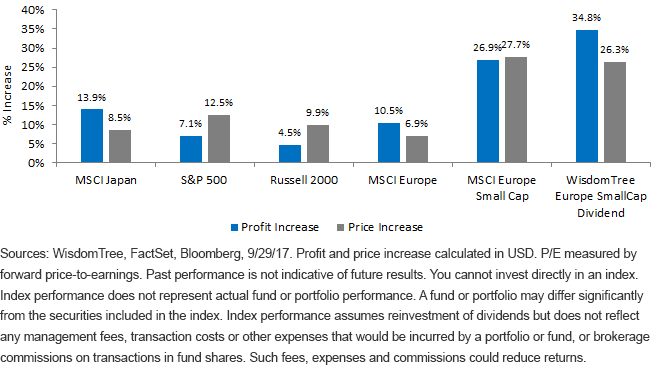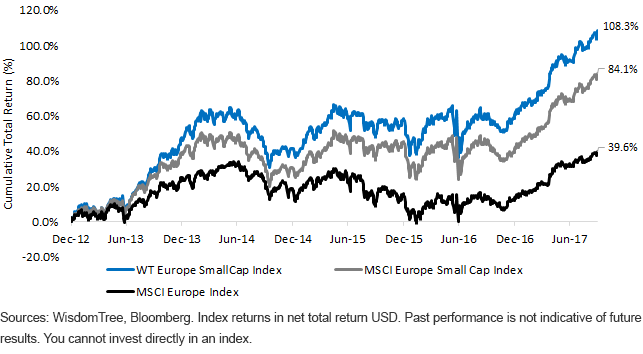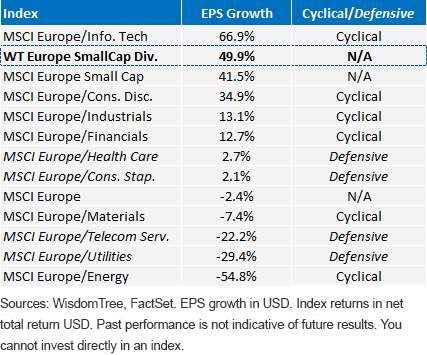The European Small-Cap Rally: What Fundamentals Are Telling Us


For investors trying to anticipate the next big inflection point for European equities amid a year of strong gains and moderate volatility, what should they be looking for from one of the best developed market equity trades of the year thus far in European small caps?
Year-to-date, Europe has largely paid off as a contrarian trade as a result of the
- Unraveling of the “Trump trade"
- Market-friendly European election outcomes
- Improving corporate earnings and economic growth
Market Multiples Falling on Strong Earnings Gains
A typical concern for investors is buying yesterday’s trade after share prices have run up and valuations have been stretched. When reviewing European small-cap valuations, surprisingly, this asset class is even less expensive today than at the beginning of the year when measured by price-to-earnings (P/E) ratios.
In decomposing the P/E ratio, the metric is agnostic to the currency impact as the numerator and denominator are denominated in the same currency. What has led to multiple contraction for European small caps has been improving earnings, as well as improving earnings growth expectations.
In comparing the multiple contraction in European small caps to U.S. small caps, as shown by the Russell 2000 Index, it is apparent that U.S. valuations have hardly changed since the beginning of the year despite lackluster returns. While U.S. small caps may surprise to the upside this fall if Washington delivers on corporate tax reform, from a valuation perspective, Europe offers an attractive discount when comparing the WisdomTree Europe SmallCap Dividend Index to the Russell 2000 Index. The valuation discount is particularly notable despite the WisdomTree Index’s price increase outpacing that of the Russell Index by more than 15 percentage points.

Price and Profit Growth

Small Caps Tapping into Cyclical Growth
Cumulative Index Total Return (Dec. 31 2012–Sept. 29 2017)

A slow eurozone recovery, beginning in large part in early 2013 with a commitment to extreme monetary policy by the European Central Bank (ECB), has resulted in small caps outperforming large by approximately 45% cumulatively since December 31, 2012, as measured by the MSCI Europe and MSCI Europe Small Cap Indexes. As gross domestic product (GDP) steadily increased over the past several quarters,1 the European Commission’s Economic Sentiment Indicator reached a 10-year high2 and the United Kingdom was able to broadly weather the economic impacts of the Brexit vote, the outperformance of small caps has accelerated in 2017 with a return advantage of more than 700 basis points (bps).3 When reviewing the picture of sector and size earnings growth since 2012, we see that small-cap earnings-per-share (EPS) growth outpaces nearly every sector that we define as cyclical during this secular recovery.
The WisdomTree Europe SmallCap Dividend Index takes this cyclical growth responsiveness a step further with a methodology that imposes a quality bias and results in an interesting sector tilt toward cyclicals. The WisdomTree Index requires that companies pay dividends on an annual basis to maintain eligibility for inclusion, and those selected dividend payers are then weighted by their regular cash dividends. As a result, the Index tilts largely toward profitable companies that have enough earnings to support their level of cash dividends. From a sector perspective, the methodology yields an 83% index weight in what we define as cyclical sectors4, compared to a 66% weight for the MSCI Europe Index.5
Earnings Growth (12/31/12–9/29/17)

For definitions of indexes in the chart, visit our glossary.
Conclusion: Accessing Value and Growth
For believers in both the small-cap value premium and the European growth story generally, now may be the time to take note of the relatively inexpensive multiples for the WisdomTree Europe SmallCap Dividend Index coupled with underlying profit growth. The WisdomTree Europe SmallCap Dividend Fund (DFE) was launched in June 2006 to track this Index, and the growth uptick in 2017, coupled with the outperformance of small caps, is just the most recent example of this strategy’s use as a vehicle to access cyclical growth.
1Source: “Eurozone GDP growth accelerates to 0.6% in Q2,” Financial Times, 8/1/17.
2Source: Trading Economics.
3Source: Bloomberg, 12/30/16–9/29/17.
4Cyclical sectors: All sectors excluding Health Care, Telecommunication Services, Utilities and Consumer Staples.
5Sources: WisdomTree, FactSet, 9/29/17.
Important Risks Related to this Article
There are risks associated with investing, including possible loss of principal. Foreign investing involves special risks, such as risk of loss from currency fluctuation or political or economic uncertainty. Funds focusing their investments on certain sectors and/or smaller companies increase their vulnerability to any single economic or regulatory development. This may result in greater share price volatility. Please read the Fund’s prospectus for specific details regarding the Fund’s risk profile.


